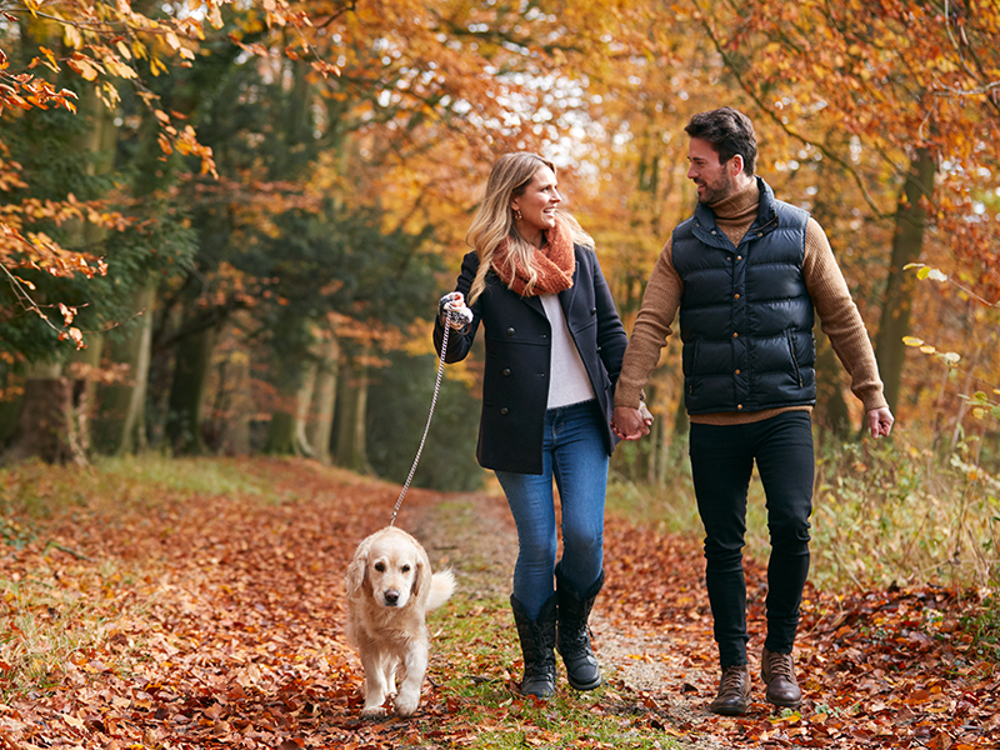
Dog walkers account for half of all visits to the UK’s outdoors, with many passionate about walking their pets in a safe and responsible way in forests, along coastlines, and through the countryside. The Government recognises that dog ownership provides key health benefits by promoting active and healthy lifestyles, thus reducing the burden on the NHS.
However, a growing population and a dwindling number of safe and accessible green spaces mean that conflict can be more likely if effective management is not pursued. Such conflict may occur in the face of sweeping and unfounded claims, such as dog walking being “bad for wildlife”.
The Kennel Club believes that the outdoors should be managed as a place for people and nature. As such, we support targeted and proportionate restrictions that are evidence-based and regularly reviewed.
Background
To maintain the health benefits of dog ownership and dog walking, it is important that people are able to easily access public spaces near them; this could include local parks, trails, or fields. Despite the Government highlighting the importance of ensuring that dogs have ample space to safely run and walk off-lead, off-lead exercise is often anecdotally claimed to be a particular problem, prompting unfounded calls for dogs to be kept on a lead at all times. Most dog walkers are happy to put their pets on a lead where necessary and will follow signage from local authorities regarding where on-lead areas start and finish - but space for off lead exercise is also vital to maintain dogs’ health and welfare.
The problem
Rather than adopting a targeted approach to restrictions, local authorities may often cite vague terms – such as “disturbance to wildlife” – as a means to justifying excessive restrictions on dog walkers. For example, in 2014, the City of London claimed restrictions on dog walking were needed for wildlife reasons at Burnham Beeches National Nature Reserve, despite the Government’s nature conservation experts finding ‘no scientific basis for controlling dogs at Burnham Beeches on nature conservation grounds’.
We believe it is important that those calling for bans or restrictions on dog walking – such as ecologists and bird enthusiasts – fully consider and recognise the wider benefits that dog walking has on both the individual and their pets and the community more generally. For example, dog walkers are able to quickly report local incidents, fly-tipping, river pollution and anti-social behaviour, all of which have a far more devastating environmental impact than dog walking.
In response to local consultations relating to dog control measures, we continually advocate for appropriate signage to ensure that dog walkers are fully aware of the restrictions in place in a specific area. Dog walkers may be unfairly blamed for being irresponsible and ignoring signage if signage has been inadvertently left in place when not needed or does not specifically indicate where the restricted area ends.
The Kennel Club’s position
Proportionate and evidence-based restrictions
The Kennel Club fully supports restrictions that are proportionate and evidence-based in nature. We believe it is vital that those implementing measures relating to dog control fully and impartially consider all available evidence and, following the enforcement of restrictions, regularly monitor and review the efficacy of the measures.
We support Natural England’s policy that restrictions on public access should be the least restrictive possible. For example, if the sensitive time for ground-nesting birds is between 1 March and 31 July, a year-round dogs on lead rules would be an inappropriate response.
Appropriate signage
Clear and accurate signage which shows where sensitive times and places for wildlife start and finish is vital to prevent conflict and allow dog walkers to act appropriately. Access management and information that tells dog walkers what they can do, such as whether their dog needs to be on a lead, and where they can go is the most effective approach to reducing potential conflict.
Displacement
Typically, additional restrictions on dog walkers – such as blanket bans or on-lead rules – result in dog walkers moving elsewhere rather than reducing dog walking overall. This has the potential to displace the problem – move it to a different location – rather than provide any solution. It is important that the displacement effects of any measures are fully considered in order to prevent the intensification of problems on sites that were otherwise quiet and sensitive for wildlife.
Plan for dog ownership
With 23% of new homes likely to contain a dog, it is important that local authorities and greenspace managers ensure that sufficient dog-friendly spaces are provided and maintained – this will reduce the risk that new developments will have on nearby sensitive wildlife areas. In 2013, we published ‘Planning for dog ownership in new developments’ to provide local authorities with suggested approaches and principles.
What you can do to help
Please follow responsible dog walking advice that applies in your area and encourage others to do the same. National guidance includes the Dog Walking Code for England and Wales, Scotland, and Northern Ireland.
Prevent your dog from approaching or chasing any wildlife or livestock and use a lead if necessary.
Always pick up and bin your dog’s poo wherever you are, including farmland, forests, and beaches. Parasites and worming chemicals found in dog faeces can kill and damage protected wildlife and plants, as well as posing a threat to any people who may come into contact with it.
Protect the places you use by quickly reporting problems, such as:
- River pollution and fly tipping – 0800 80 70 60
- Rural crime (Crimestoppers) – 0800 555 111
- Illegal poisoning of wildlife and pets – 0800 321 600
- Forest and heathland fires – 999
For more detailed information, please get in touch with us via email or on Twitter.
